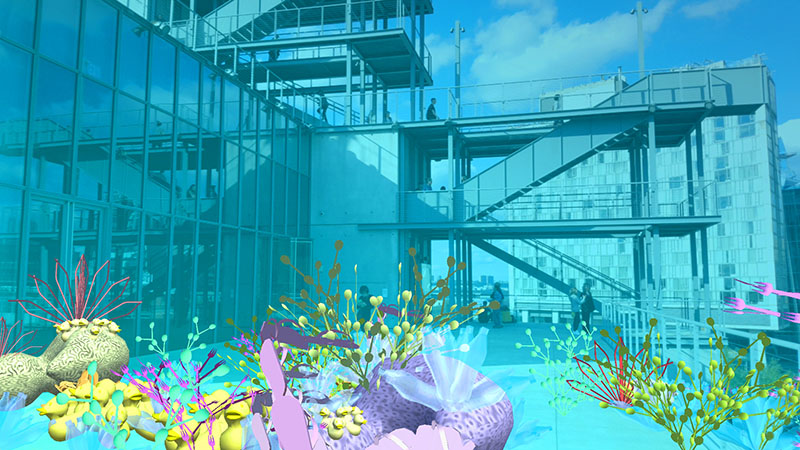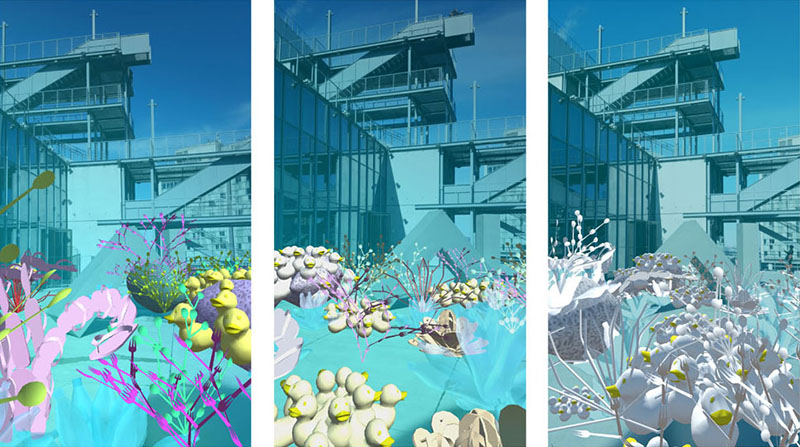Unexpected Growth
Augmented Reality Installation by Tamiko Thiel and /p, 2018In the collection of the Whitney Museum of American Art New York. Commissioned for the exhibition: "
Programmed: Rules, Codes, and Choreographies in Art, 1965–2018"
September 28, 2018 – April 14, 2019
Press release

Unexpected Growth on the 6th floor terrace, Whitney Museum of American Art, New York

Unexpected Growth, showing 3 phases of bleaching
Video recording of 3 phases of Unexpected Growth on the Whitney 6th floor terrace, 2018
Perturbations in the natural order have torn the fabric of the space-time continuum, and unexpected growths are seeping into our world - perhaps from our own future. Augmented reality apps transform our mobile devices into "ARscopes;" allowing us to see into these parallel dimensions that co-exist and overlay our own so-called "reality."
One such growth has been discovered on the 6th floor terrace of the Whitney Museum of American Art. The growths are movable, and are periodically reshuffled by passing waves.
This strange growth seems to respond to the mediated human gaze on a daily cycle, absorbing electromagnetic energy from our "ARscopes." Over the course of a day, depending on the number of people viewing it, the accumulated exposure seems to cause the growth to bleach. More investigation and longer terms studies will be needed to see the longer term effects of human interference with its growth cycle.
What we can say so far is that the growths seem to be an odd mixture of coral animals and plastic. They are clearly following principles of Lindenmayer systems, algorithmic, branching growth as is common in many corals. It is unclear however how the plastics are becoming incorporated into living systems, and what effects these coral-plastic symbioses will have on the larger ecosystems, especially on animals all along the foodchain - up to human beings - who feed off of sea flora and fauna.
Another troublesome aspect is that the reefs on the 6th floor terrace are clearly underwater. If they are really coming from our future, when will the waters of New York Harbor reach this disturbingly high level? Are such symbioses our future, as plastic waste becomes more numerous than the fish in the sea?
"Programmed: Rules, Codes, and Choreographies in Art, 1965–2018" is organized by Christiane Paul, Adjunct Curator of Digital Art, and Carol Mancusi-Ungaro, Melva Bucksbaum Associate Director for Conservation and Research, and Clémence White, curatorial assistant.
Threats to Ocean Ecosystems in the Anthropocene
Unexpected Growth seeks to playfully engage the public in two very serious threats to ocean ecosystems: ocean borne plastic waste and coral bleaching caused by global warming. The links below are a work in progress as I seek positive responses to how they can be solved - or at least ameliorated.When we conceived the project we though we were creating a science fiction future scenario. But in 2019 divers discovered what they thought was a new coral reef off the coast of Greece was actually entirely made of plastic garbage - from an illegal waste dump, swept into the sea by storms.
Preventing catastrophic global warming is technically possible but politically difficult. Corporations and governments will not take action unless we put massive pressure on them. If you really do love your children and your grandchildren, get active NOW to give them a planet worth living on.
Ocean borne plastic waste
Plastics have now permeated not only the earth's entire ocean ecosystem but also entered the entire human food chain and our bodies, with probable consequences for our health. And yes, corals do injest plastics too!Plastic waste can range from huge sections of buildings and vehicles destroyed in storms to microplastics from abrasion, fibers from washing synthetic fabrics and tiny pieces from degradation of larger objects. Algae grows on plastics, attracting marine animals and birds who die when they mistake them for food.
Organizations like the Ellen MacArthur Foundation are forming broad coalitions, including governments and corporations, to rethink the entire plastics economy.The problems include how to:
- Eliminate plastics, especially single use plastics. Each of us can start by reducing our own use of plastics, but we need to put pressure on governments and corporations too.
Greenpeace offers a "Million Acts of Blue" toolkit
for with ideas on how to proceed. Some countries are starting to ban certain single use plastics already.
"Bioplastics" e.g. from Lego reduce the carbon footprint of production, but are NOT biodegradable. Industrial farming of plants for plastics and biofuels can destroy the environment and push marginal farmers into poverty.
- The Global Ghost Gear Initiative addresses "ghost nets" - lost or abandoned fishing nets - that make up
46% of the ocean garbage patches, together with other
fishing gear (ropes, traps, crates, baskets).
Hawai'i burns ghost nets to generate electric power. Companies like Econyl are trying to recycle fishing nets and other ocean waste into carpet and textile yarn. And Australian artists "upscale" the ghost nets into artworks.
- Improve waste recycling and elimination. China is the largest source of ocean plastics - due to waste mis-management but also because until 2018 Western countries shipped their waste to China for disposal. The USA recycled only 9% of its waste, even before this, and is now
struggling to deal with all of its waste itself - perhaps why there is a surge of interest in dealing with plastic waste, as the problem can't be exported anymore.
Indonesia, with the world's 4th largest population and a huge total coastline, is the second largest source, and is finally starting to address the problem. Foreign aid for waste management in developing countries can benefit in many ways - e.g. learning from a town in the Philippines that "upgraded" waste pickers to civil servants.
Innovative ideas upcycle plastics, such as this building in Taiwan (more photos here).
There are newly discovered plastic-eating bacteria, but tinkering with ecosystems can often create even larger unforeseen problems.
- Catch plastics before they enter the oceans (at the rate of one truckload every hour). Baltimore Waterfront commissioned trash wheels to collect river borne trash. Ranmarine is marketing their "WasteShark" internationally.
- Clean up plastics already in the oceans: The Ocean Cleanup Project
has received $35 million in funding and promises to "clean up all the oceans in 10 years" - but only addresses large pieces of the 1% floating near the surface.
In 1992 a shipping container with 28,000 plastic bath toys fell into the ocean. As they began appearing on the West Coast of the USA, oceanographer Curtis Ebbesmeyer used them to track world-wide ocean currents. With time the bath toys turned up in the Atlantic as well, in Maine and Scottland. Among these, the Rubber Ducky became the icon of world-wide ocean-borne jetsam.
In 1997, Charles Moore discovered the world’s largest collection of floating trash (subsequently nicknamed the Great Pacific Garbage Patch by Ebbesmeyer). His Algalita Marine Research Foundation to educates people how to fight plastic pollution.
Global warming & coral bleaching
Coral reefs are the most diverse marine ecosystems, providing habitats to 25% of ocean species. Coral polyps live in symbiosis with algae, but expell them - bleaching - when stressed. (See National Geographic video @2:20m for coral expelling its algae). Warming global waters are causing more frequent bleaching without time to recover. A global temperature rise of 2.7°F (1.5°C) by 2040 will kill 70%-90% of coral reefs; a 3.6°F (2°C) rise will kill 99% - and they need millions of years to recover. Some corals are more resistant to higher temperatures. If they can be " transplanted" to a dead reef they might revive an area - but the death of a reef will eliminate many of the dependent species quickly, and a reef revival will take a long time. Diving and snorkeling can endanger the very reefs that tourists go to see. Green Fins advises and rates diving centres for sustainable, coral reef friendly practices.Global warming & climate change: The United Nations Intergovernmental Panel on Climate Change issued a blunt report in 2018: we have less than 10 years to reduce CO2 emissions. Failing to do so will bring worsening world food shortages, wildfires, sea level rise, a mass die-off of coral reefs and other catastrophic effects by or before 2040.
Ways to address climate change:
- Grassroots movements like Extinction Rebellion (Wikipedia entry) and 350.org (Wikipedia entry) are organizing demos to pressure governments and corporations to act now, before it is too late. Greenpeace lists many different ways to take action.
- Shareholder groups such as Climate Action 100+ and organizations like 350.org are putting pressure on companies to reduce emissions. Royal Dutch Shell promised to link executive pay to hitting carbon emissions targets starting in 2020.
- Project Drawdown claims
that there is actually much that individuals can do, saying the four most effective ways of
reducing carbon emissions include refrigerant management, reduced food waste and a plant-rich diet.
Individual choices do add up - studies show eating beans instead of beef, or at least reducing meat and animal product consumption, would make a huge difference.
- Carbon offsets: a lot of projects may be mere "greenwashing," but the Gold Standard is well regarded for certifying projects. Communities dependent on coral reefs for their livelyhood can be helped work towards sustainable ecologies
Privacy policy:
Unexpected Growth contains custom software for geolocative positioning of AR content that requires the user's GPS position. This data is used only for positioning the AR content at the user's location, and is not stored or shared. This website follows the German Datenschutzerklärung (data privacy policy) of its hosting website www.mission-base.com.
© Tamiko Thiel and /p, 2018